|
OK, let's get one thing straight. Frankenstein isn't a true story and was never claimed to be. I never quite got why this TV mini-series adaptation of the novel by the then 19-year-old Mary Wollstonecraft Shelley came to be so titled. It's intriguing, for sure, suggesting that in her genre-defining story, the good Ms. Shelley had somehow played games with the facts. Never mind what you've read or seen in other films, it appears to proclaim, this is what really happened. Here Victor Frankenstein is not the brilliant scientist suggested by Shelley, but a curious doctor whose reputation for constructing a man from the parts of others and giving him life was actually the work of more inventive minds. It's a neat idea, an inventive twist on an oft-told story. But true? Do me a favour.
Frankenstein: The True Story was made by Universal Studios for US TV and designed to be shown in two feature-length parts. And that's feature-length by mid-1970s standards, not the overblown average that is the norm today. As a pre-cable, made-for-television movie, it was inevitably subject to restrictions on what it could show (no nudity, no graphic horror), and in that respect there are a couple of surprises here and one neat piece of editorial misdirection. And despite being made for American television and directed by busy local boy Jack Smight (he of The Illustrated Man and Airport 1975), it was shot at Pinewood Studios with a few exterior jaunts into the Buckinghamshire countryside, was co-written by celebrated novelist and Cabaret story writer Christopher Isherwood, and features a largely British cast, complete with a spattering of famous names to give it the air of a prestige production. It's also held in very high regard. I certainly had fond memories of it when I requested the review disc. I seem to remember my fellow reviewer Jerry Whyte also recalling it with some excitement when we discussed it over a beer. As you do. So how does this 1973 made-for-TV movie stand up against the sizeable huddle of feature adaptations that preceded and followed it? Damned well, as it happens.
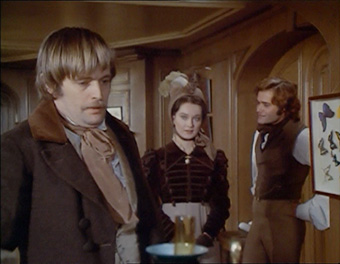
It starts at the sort of hurried gallop that suggests a once longer intro has been severely trimmed for the final edit. Victor loves his fiancée Elizabeth. He also loves his younger brother William. William dies in a boating accident. William is buried. Victor renounces God and tells the morally uptight Elizabeth that he'd gladly make a pact with the Devil if it would bring his brother back to life. Total elapsed screen time, two minutes.
The pace slows to a more manageable speed when Victor travels to London to study anatomy and falls in with tetchy and defensive scientist Henry Clerval, who is using electricity to bring dead insects back to life. He is even able to reanimate a severed human arm which, in one of my favourite moments, grasps Victor's hand and prompts Henry to respond with gleeful enthusiasm, "it knows you!" But what Henry really wants is a human subject, which he and Victor subsequently assemble from the body parts of victims of a mining accident. But the night before they are due to kick their creature to life, Clerval falls victim to his failing heart. Victor finds him the next morning, his notebook containing the incomplete sentence, "The process is r...", which he rather recklessly interprets as "The process is ready." He thus transplants Henry's brain into the creature and proceeds with the reanimation, unaware that shortly before he expired Henry discovered a serious flaw in his method and was actually writing, "The process is reversing." Oops.
In a stark deviation from the Frankenstein monster of movie lore, Henry and Victor's 'second Adam' is a devilishly good-looking fellow (the first word he learns is "beautiful" in reference to his own appearance) and is blessed with a child-like curiosity and willingness to learn. In no time at all, Victor is introducing him to others as a visitor from foreign parts with no command of the English language, a twist on the tale that was touched on previously in Hammer's Revenge of Frankenstein but is still very nicely handled here. And in an inventive and ecologically sound alternative to the lightning strike of the novel, the forward-thinking Henry grabs the power he needs using what bears a strong resemblance to a modern solar thermal collector dish. Mind you, if we were able to harness the amount of power from the sun that Henry channels here, we could happily kiss nuclear energy goodbye.
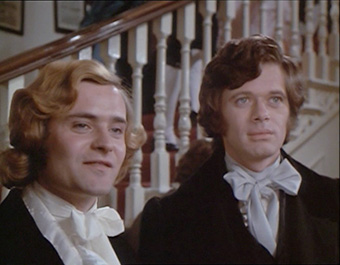
So successful is Victor's deception and so charming is The Creature that you genuinely start to hope that whatever went wrong with Henry's reanimated arm will not be duplicated here. But we're clued in at an early stage to the growths that signal it's all going to go bad, and so get to watch poor Victor living an illusion until he too catches sight of this ominous malformation. Without Henry to turn to, our Victor simply doesn't have the knowledge or experience to do much about it, and rather selfishly channels his frustrations at The Creature, whose lovely looks gradually deteriorate to those of a quasi-Neanderthal brute. It's a bit like a surgeon treating his patient like crap because he botched the man's surgery. Which is, of course, pretty much what happened. It's thus lucky (or, given the circumstances, a bit unlucky) for Victor that his progress is being monitored by Henry's former tutor and scientific nemesis Dr. John Polidori.
As drama this proves to be captivating stuff, and by using the novel as a narrative springboard for the story rather than a rigid template, Isherwood and co-writer Don Bachardy spin a tale that differs enough from that of other film adaptations to still feel reasonably fresh today. Previous film versions – James Whale's Bride of Frankenstein in particular – prove as ripe a picking ground as the original novel, and Isherwood and Bachardy go their own way with both. Thus the childhood friend from the novel who nurses Victor back to health becomes the scientist from whom he learns his skills and whose brain is transplanted into The Creature's body. Polidori, meanwhile, was clearly inspired by Bride of Frankenstein's Dr. Pretorious, while his name has been borrowed from the author whose novel The Vampyre sprang out of the same rainy summer's night that gave birth to Frankenstein. Elsewhere, aspects of the book and its film adaptations are spliced together, as with the woodland family that The Creature spies on and learns from, whose patriarch is the blind man that provided Whale's justly celebrated sequel with its most touching scene.
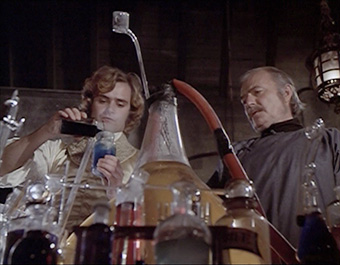
The Creature's request that Victor provide him with a mate has also been developed from the novel and Whale's film interpretation. As with Pretorious in Bride of Frankenstein, it's Polidori who persuades Victor to come on board. And The Creature isn't looking for any old mate. He wants Polidori and Doctor F. to resurrect the blind man's daughter Agatha, a girl with whom he had become rather smitten, right up to the moment she was killed by a carriage whilst running away from him. Polidori, it turns out, has ambitions far beyond those of Henry Clerval and wants to create a woman so spellbinding to men that he can use her to change the balance of world power. By transplanting Agatha's undamaged head onto the body of another to create the beautiful Prima, he takes his first step towards this lofty goal. What could possibly go wrong? Oh, you just wait.
On the Trivia section of the film's IMDb page, the suggestion is that screenwriters Isherwood and Bachardy were deeply unhappy with the finished film and wanted John Voigt to play Victor and John Boorman to direct. I don't have a copy of their published screenplay – which does differ from the finished product – and despite some research have not been able to confirm this claim one way or another. Certainly having a filmmaker as distinctive as Boorman in charge would have resulted in a very differently toned film. But while top flight directors now seem to be queuing up to work on American TV, back in the 70s helming a made-for-TV movie was generally regarded as a sign that your career was on a downward trajectory. Jack Smight clearly had no such pompous delusions, and despite having directed a number of successful cinema features, he started out in television and had worked in the medium a good many times since. And while the 4:3 aspect ratio and the sometimes TV-friendly lighting may occasionally betray its televisual origins, the film still looks great (kudos to Arthur Ibbeson's photography, Wilfrid Shingleton's production design and Roy Whybrow's impressive special effects), and Smight does a bang-up job on the pacing and the direction of his actors. And they all deliver here, from Leonard Whiting's troubled enthusiasm as Victor to James Mason's wonderfully oily self-confidence as Polidori. A boffo supporting cast includes such luminaries as Michael Wilding, Agnes Moorhead, Nicola Pagett, Margaret Leighton, John Geildud and Ralph Richardson. And yes, that's Peter Sallis as the disapproving priest and a pre-Dr. Who Tom Baker as the beardy sea captain in the memorable final act.
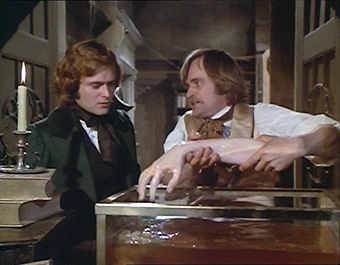
Yet despite such lofty competition, it's a trio of key supporting players who end up stealing the acting honours. As the tormented and furiously intense Henry Clerval, David McCallum gives a forceful demonstration of just how good an actor he could be when freed of Illya Kuryakin's Russian accent. So strong is his performance here that I let out an audible groan when his character stumbled to his death, despite having seen the film many years ago and being well aware that the event was coming. As the delectable Prima, Jane Seymour may only seem to have to look pretty and confident for much of the time, but just watch her face when she is confronted by The Creature at a swanky ball, shortly before... no, that's a scene you should see for yourself and one that anyone who knows the film will recall in an instant. Best of all is Canadian actor Michael Sarrazin (what happened to him?), whose portrayal of The Creature requires him to undergo a gradual transformation from childlike innocent to vengeful beast, and he's utterly and completely convincing all the way. The sequence in which he walks into the ball at which he confronts Prima is one of my all-time favourite horror movie moments, and so much of that is due to Sarrazin's body language and vengeful expression. And what Sarrazin emotes when the creature first catches sight of his post-transformation reflection will break your heart.
Over forty years after it was first made and broadcast, Frankenstein: The True Story still stands up as one of the most imaginative and enthralling takes on young Mary Shelley's genre-shaping novel. The games it plays with the original text all build on concepts in the original story (you can stuff comic book piffle like the recent I, Frankenstein right up your arse), and the script and performances alone make this a winner. So no, it's not a true story, not by a long shot, but it is a damned fine one most worthy of this telling.
An expensive production by TV Movie standards on the early 70s and doubtless shot on 35mm film, you can't help wondering just how lovely Frankenstein: The True Story would look if digitally restored from the original negative. That's not what we get here. Framed aproximately 1.28:1 (there is very slight windoboxing at both sides), as it was originally broadcast, the image sharpness varies from rather well detailed to being on the soft side, sometimes on a shot-to-shot basis. Suspicions that this is the result of an NTSC to PAL conversion from a high-band tape original appear to be unfounded – there is no trace of ghosting whatsoever on edits or movement. The picture is impressively clean, with almost no dust spots or damage. The colour is slightly muted in that manner we tend to associate with some TV material of the period, though the odd burst of more vivid coloured lighting is there.
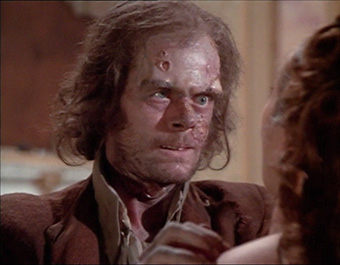
The Dolby Digital 2.0 mono soundtrack is a reasonable job, being clear of damage and betraying only a hint of background hiss. The dynamic range is somewhat limited, however, having little brightness in the trebles and no punch to the bass.
Optional English subtitles are included.
Introduction by James Mason (5:31)
The short introduction by the lovely James Mason that aired before the original TV screening, a dangerous watch if you've not seen the film as it's littered with plot-spoiling extracts.
One of the best of all Frankenstein films on a serviceable DVD. A properly remastered transfer with a crisper picture would have been preferable, but it's still great to have it available again on UK DVD. Hard to wholeheartedly recommend the disc on this basis, but for the film alone it's still worth picking up if you can get a good price.
|